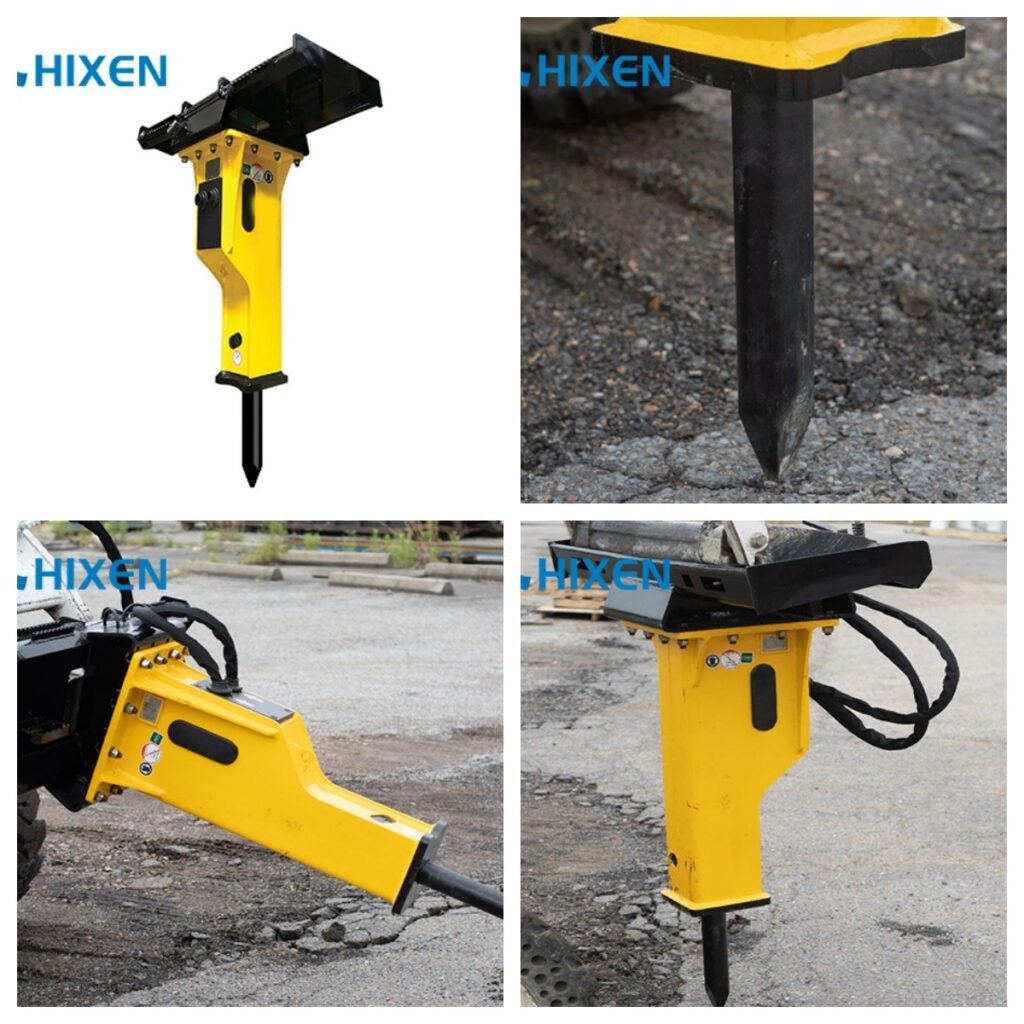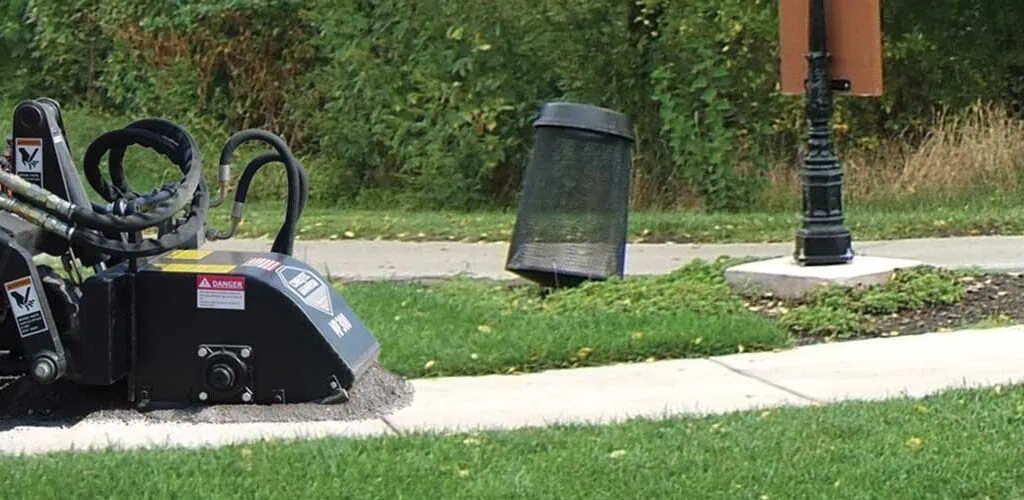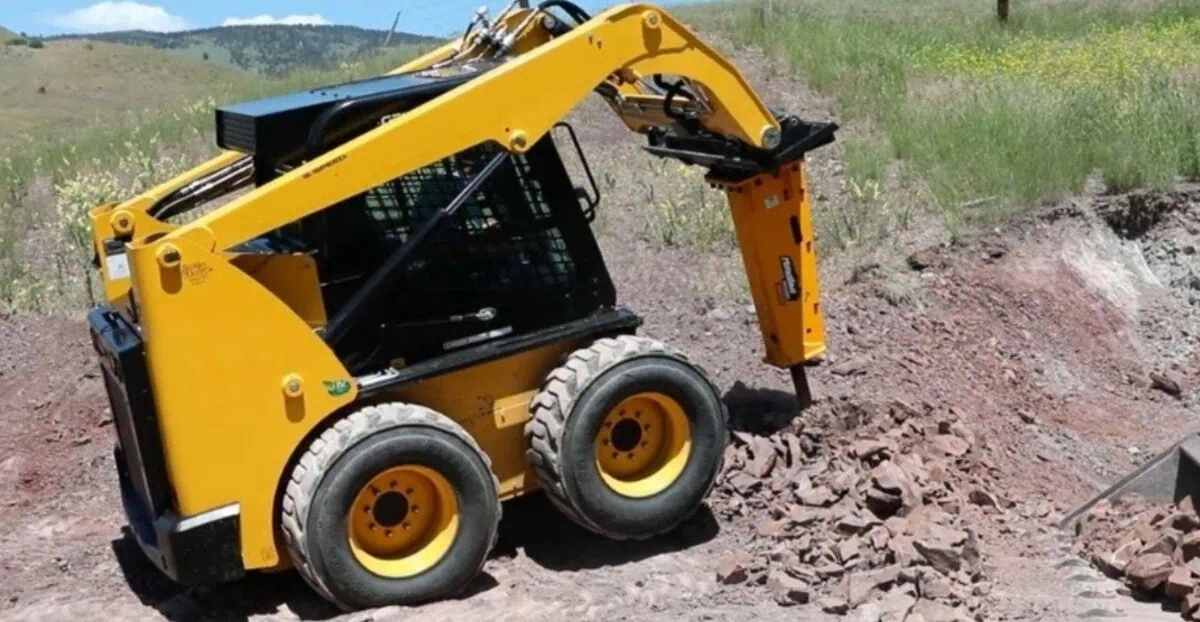In various construction and engineering scenarios, the demolition operation is extremely common and crucial. From the demolition of urban old buildings, road renovation, and reconstruction, to the mining industry, the breaking of hard objects is indispensable. As an efficient demolition tool, the skid steer breaker attached to the skid-steer loader, with its unique advantages, plays a vital role in numerous projects.
It not only improves the efficiency of the demolition operation but also provides strong support for the flexibility and diversity of construction. Next, we will delve into the working principle, characteristics, application scenarios, maintenance, and future development trends of the skid-steer loader attachment breaker.
Table of Contents
ToggleI. Working Principle
(I) Hydraulic Drive Principle
The breaker attached to the skid-steer loader mainly relies on the hydraulic system to provide power. Our skid-steer loader is equipped with a powerful hydraulic pump that can generate high-pressure hydraulic oil. After the breaker is connected to the skid-steer loader and started, the hydraulic pump transports the high-pressure hydraulic oil to the hydraulic cylinder inside the breaker through pipelines. Inside the hydraulic cylinder, the pressure of the hydraulic oil drives the piston to move back and forth.
One end of the piston is connected to the drill rod. When the piston impacts the drill rod at high speed under the action of hydraulic oil, the drill rod will strike the objects to be broken, such as concrete and rocks, with extremely high frequency and strong impact force, thus achieving the demolition operation.
(II) Impact Mechanism
The impact mechanism of the breaker is the core component for achieving efficient demolition. Common impact mechanisms include piston-type and nitrogen-type. Taking the piston type as an example, the piston moves at high speed along the inner wall of the cylinder under the push of hydraulic oil. When the piston reaches the end of the stroke, it will impact the drill rod at a great speed, transmitting energy to the drill rod.
To ensure the stability and efficiency of the impact, the breaker is also equipped with precise control valves inside, which can accurately control the flow and pressure of the hydraulic oil, and then adjust the movement speed and impact frequency of the piston. At the same time, the nitrogen-type impact mechanism uses the compressibility of nitrogen to store and release energy during the movement of the piston to enhance the impact effect.
This design enables the breaker to flexibly adjust the impact force and frequency according to different working conditions and objects to be broken, improving the demolition efficiency.

II. Characteristics
(I) High Efficiency
Powerful Impact Force
The breaker can generate extremely high impact force. When facing hard concrete structures, large rocks, etc., it can break them quickly. Compared with the traditional manual demolition method, the working efficiency of the breaker can be increased several times or even dozens of times. For example, in the demolition project of the concrete pavement of an urban road, a skid-steer loader equipped with a suitable breaker can complete a much larger demolition area in one day than manual workers using tools like pneumatic picks can achieve in several days.
High-frequency Impact
The breaker has a relatively high impact frequency and can strike the object to be broken multiple times in a short period. This high-frequency impact can make the demolition effect more uniform and reduce the situation of incomplete local demolition of the object. Taking the demolition of the pier of an old bridge as an example, the high-frequency impact of the breaker can quickly break the concrete shell of the pier and then penetrate into the internal reinforced concrete structure for destruction, greatly shortening the demolition time.
(II) Flexibility
Compatibility with Skid – steer Loaders
As an attachment to the skid-steer loader, the breaker can make full use of the compact and flexible characteristics of the skid-steer loader. Our skid-steer loader has excellent steering performance and a small turning radius, enabling it to move freely in narrow construction sites. Whether it is the demolition of buildings in narrow alleys in urban blocks or the demolition of local walls in interior decoration projects, the skid-steer loader can easily reach the working position and then quickly change to the breaker for work. This flexibility is incomparable to large-scale demolition equipment.
Multiple Working Angles
After the breaker is installed on the skid-steer loader, it can be adjusted at multiple angles through the hydraulic system of the skid-steer. The operator can flexibly adjust the striking angle of the breaker according to the position and shape of the object to be broken, ensuring that the demolition operation can be carried out at the best angle and improving the demolition effect. For example, when demolishing some buildings with irregular shapes, the breaker can be adjusted to different angles to accurately break each part.

(III) Economy
Advantage in Equipment Cost
Compared with specialized large-scale demolition machinery, the acquisition cost of the skid-steer loader attachment breaker is relatively low. For some small-scale construction enterprises or enterprises that occasionally need to carry out demolition operations, purchasing a skid-steer loader and equipping it with a breaker attachment can not only meet the daily demolition needs but also not occupy excessive funds. Moreover, in addition to the breaker, the skid-steer loader can be equipped with many other attachments, such as buckets and forks, achieving multi-function operation and further improving the cost-effectiveness of the equipment.
Low Maintenance Cost
The breaker has a relatively simple structure, and its main components are easy to disassemble and maintain. In daily use, as long as the maintenance is carried out according to the correct operation methods and maintenance procedures, and the easily worn parts such as hydraulic oil and filters are replaced regularly, the normal operation of the breaker can be ensured. Compared with some complex large-scale demolition equipment, the maintenance cost of the breaker is significantly reduced, which is of great significance for enterprises to reduce operating costs.
III. Application Scenarios
(I) Building Demolition
Demolition of Urban Old Buildings
During the urban renewal and transformation process, a large number of old buildings need to be demolished. The skid-steer breaker, with its flexibility and high efficiency, can demolish various buildings in complex urban environments. For some small-scale multi-story buildings, the breaker can start from the bottom floor of the building and carry out demolition floor by floor, avoiding the problem that large-scale demolition equipment is difficult to operate in narrow urban streets. At the same time, the precise striking of the breaker can reduce the impact on surrounding buildings and ensure the safe progress of the demolition work.
Indoor Demolition Operations
In interior decoration projects, it is often necessary to demolish the original walls, floors, etc. The skid-steer loader, with its compact size, can easily enter the indoor space. After changing to the breaker, it can quickly and accurately break the indoor concrete structures. Compared with manual demolition using tools such as sledgehammers, not only is the efficiency greatly improved, but also the demolition range can be better controlled, reducing damage to surrounding decoration facilities.
(II) Road Construction
Road Surface Demolition and Renovation
With the increase in traffic flow and the growth of service life, many roads need to be renovated. The breaker can be used to break the old concrete road surface, crushing it into an appropriate particle size for subsequent re-paving. During road construction, the flexibility of the skid-steer loader enables the breaker to operate under different road sections and road conditions, improving construction efficiency. For example, in some local repair projects of urban roads, the breaker can quickly break the damaged parts of the road surface, creating conditions for the laying of the new road surface.
Breaking of Road Foundations
During the foundation construction stage of road construction, it is sometimes necessary to break hard rock foundations or old road bases. The powerful impact force of the breaker can effectively break these hard objects, laying a good foundation for the subsequent road foundation leveling and paving work.

(III) Mining Operations
Small – scale Mining
In some small-scale mines, due to site and mining scale limitations, large-scale mining equipment may not be able to fully play its role. The skid-steer loader attachment breaker, with its flexibility and high efficiency, becomes a powerful tool for small-scale mining. It can break the ore in narrow mine tunnels, crushing large pieces of ore into small pieces that are easy to transport and process. For example, in some small-scale limestone mines, the breaker can directly carry out preliminary breaking of limestone at the mining site, improving the ore mining efficiency.
Auxiliary Mining Operations
During large-scale mining operations, the breaker can also be used as an auxiliary tool. For example, in the ore cleaning work after blasting, the breaker can re-break some large pieces of ore that are not completely broken to ensure that the particle size of the ore meets the requirements of subsequent processing equipment. At the same time, during the tunneling process in the mine, the breaker can be used to break the rocks around the tunnel to widen the tunnel space.
IV. Maintenance
(I) Daily Inspection
Appearance Inspection
Before each use of the breaker, the operator should carefully inspect its appearance. Check whether there are cracks, deformations, etc. on the shell of the breaker and whether the bolts at the connection parts are loose. If cracks are found on the shell, the use should be stopped immediately and repaired to avoid the expansion of the cracks during operation, resulting in damage to the breaker. For loose bolts, they should be tightened in a timely manner to ensure the stability of the breaker during operation.
Pipeline Inspection
Check whether there is any leakage in the hydraulic pipelines, including the joints of the oil pipes, seals, and other parts. The leakage of hydraulic oil not only affects the working efficiency of the breaker but may also cause environmental pollution. Once the leakage of hydraulic oil is detected, the leakage point should be found in time, and the damaged seals or oil pipes should be replaced. At the same time, also check the fixing situation of the pipelines to ensure that the pipelines will not fall off due to vibration during operation.
(II) Regular Maintenance
Hydraulic Oil Replacement
Hydraulic oil is the key to the normal operation of the breaker. Generally, the hydraulic oil needs to be replaced every certain number of working hours (such as 500 – 1000 hours). When replacing the hydraulic oil, high-quality hydraulic oil that meets the equipment requirements should be used, and the hydraulic oil tank and filter should be thoroughly cleaned to remove impurities and metal shavings in the oil. After the new hydraulic oil is injected, check whether the oil level is within the normal range.
Filter Replacement
The hydraulic system of the breaker is equipped with multiple filters, including suction filters and return filters. These filters are used to filter the impurities in the hydraulic oil and ensure the cleanliness of the hydraulic system. Regular replacement of the filters (generally every 200 – 500 hours) can effectively prevent impurities from entering the hydraulic components and extend the service life of the breaker. When replacing the filters, pay attention to selecting the filter models that match the equipment and install them according to the correct method.
(III) Maintenance of Key Components
Piston and Drill Rod
The piston and drill rod are key components of the breaker, which bear huge impact force during operation. Regularly check whether there is wear, scratching, etc. on the surface of the piston. If there is slight wear, it can be repaired, and if the wear is severe, the piston needs to be replaced. For the drill rod, check the wear degree of its head. When the head of the drill rod is worn to a certain extent, it should be replaced in a timely manner to ensure the demolition effect. At the same time, during use, pay attention to applying an appropriate amount of lubricating oil to the drill rod to reduce wear.
Maintenance of the Nitrogen Chamber
For breakers with a nitrogen-type impact mechanism, regularly check the nitrogen pressure in the nitrogen chamber. Excessive or too low nitrogen pressure will affect the impact performance of the breaker. Generally, for every certain period of work (such as 100 – 200 hours), a professional nitrogen pressure gauge is needed to check the pressure in the nitrogen chamber and adjust it according to the requirements of the equipment. When replenishing nitrogen, it is necessary to follow the operating procedures strictly to ensure safety.

V. Future Development Trends
(I) Intelligent Development
Intelligent Control System
In the future, the breaker is expected to be equipped with a more advanced intelligent control system. Through sensors, it can monitor the working status of the breaker in real-time, such as impact frequency, impact force, oil temperature, and other parameters, and feedback on these data to the operator or link with the control system of the skid-steer loader. According to the monitored data, the intelligent system can automatically adjust the working parameters of the breaker to adapt to different working conditions and achieve the best demolition effect. For example, when encountering rocks with higher hardness, the system automatically increases the impact force and impact frequency; when the hardness of the rocks decreases, the relevant parameters are automatically reduced to save energy and reduce equipment wear.
Fault Diagnosis and Early Warning
The intelligent system will also have the functions of fault diagnosis and early warning. When a potential fault occurs in the breaker, the system can issue an alarm in a timely manner and accurately point out the fault location and cause through data analysis. This will greatly shorten the equipment repair time and improve the reliability and availability of the equipment. The operator can make repair preparations in advance according to the early-warning information, avoiding construction interruptions caused by sudden faults.
(II) Energy Conservation and Environmental Protection
Optimization of the Hydraulic System
In order to reduce energy consumption, the hydraulic system of the breaker will be further optimized in the future. By adopting new-type hydraulic components and control technologies, the efficiency of the hydraulic system can be improved, and energy losses can be reduced. For example, developing more efficient hydraulic pumps and control valves to make the control of the flow and pressure of hydraulic oil more precise, while meeting the needs of the demolition operation, reducing the energy consumption of the hydraulic system.
Application of Alternative Energy Sources
With the continuous improvement of environmental protection requirements, the breaker may gradually explore the use of alternative energy sources. For example, the research and development and application of electric breakers will become a development direction. The electric breaker, powered by electricity, has the advantages of low noise and no pollution compared with the traditional hydraulically-driven breaker. At the same time, with the continuous progress of battery technology, the battery life and power performance of the electric breaker will also be continuously improved, enabling it to be applied in more construction scenarios.
(III) Multi-function Integration
Integration with Other Attachments
In the future, the breaker may be more integrated with other attachments of the skid-steer loader to achieve multi-function integration. For example, by combining the breaker with a crushing and screening device, while crushing, the materials can be screened to directly obtain materials with the required particle size, reducing subsequent processing links. Or integrating it with a material handling device, after the demolition operation is completed, the broken materials can be quickly transported to the designated location, improving the construction efficiency.
Expansion of Application Fields
With the development of technology, the application fields of the breaker will continue to expand. In addition to the existing construction, road, and mining fields, it may be applied in more emerging fields, such as the breaking of underwater rocks in marine engineering and the rock sampling and breaking in geological exploration. This will further increase the market demand and application value of the breaker.
VI. Conclusion
The skid steer breaker, with its unique working principle, high-efficiency and flexible characteristics, and wide range of application scenarios, plays an important role in the field of construction engineering. Through reasonable maintenance, its long-term stable operation can be ensured, bringing good economic benefits to enterprises. With the progress of science and technology, the development trends of the breaker in terms of intelligence, energy conservation environmental protection, and multi-function integration will enable it to have a broader application prospect in future construction projects. Whether it is a small-scale construction project or large-scale infrastructure construction, the skid steer breaker will continue to serve as a versatile and efficient demolition tool, contributing to the development of the construction industry. Construction enterprises should pay close attention to the technological development trends of the breaker, reasonably select and use this tool to improve their construction capabilities and market competitiveness.
